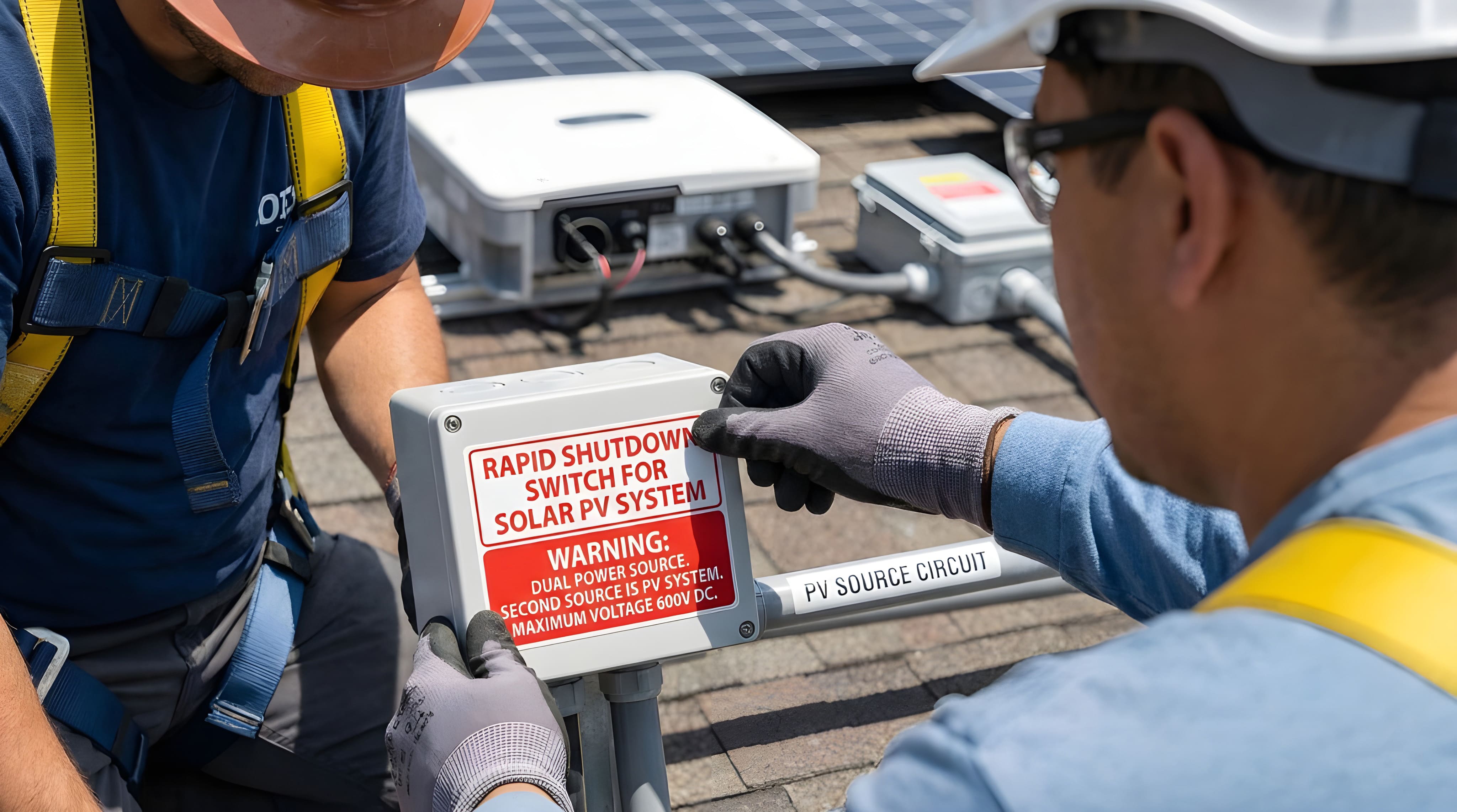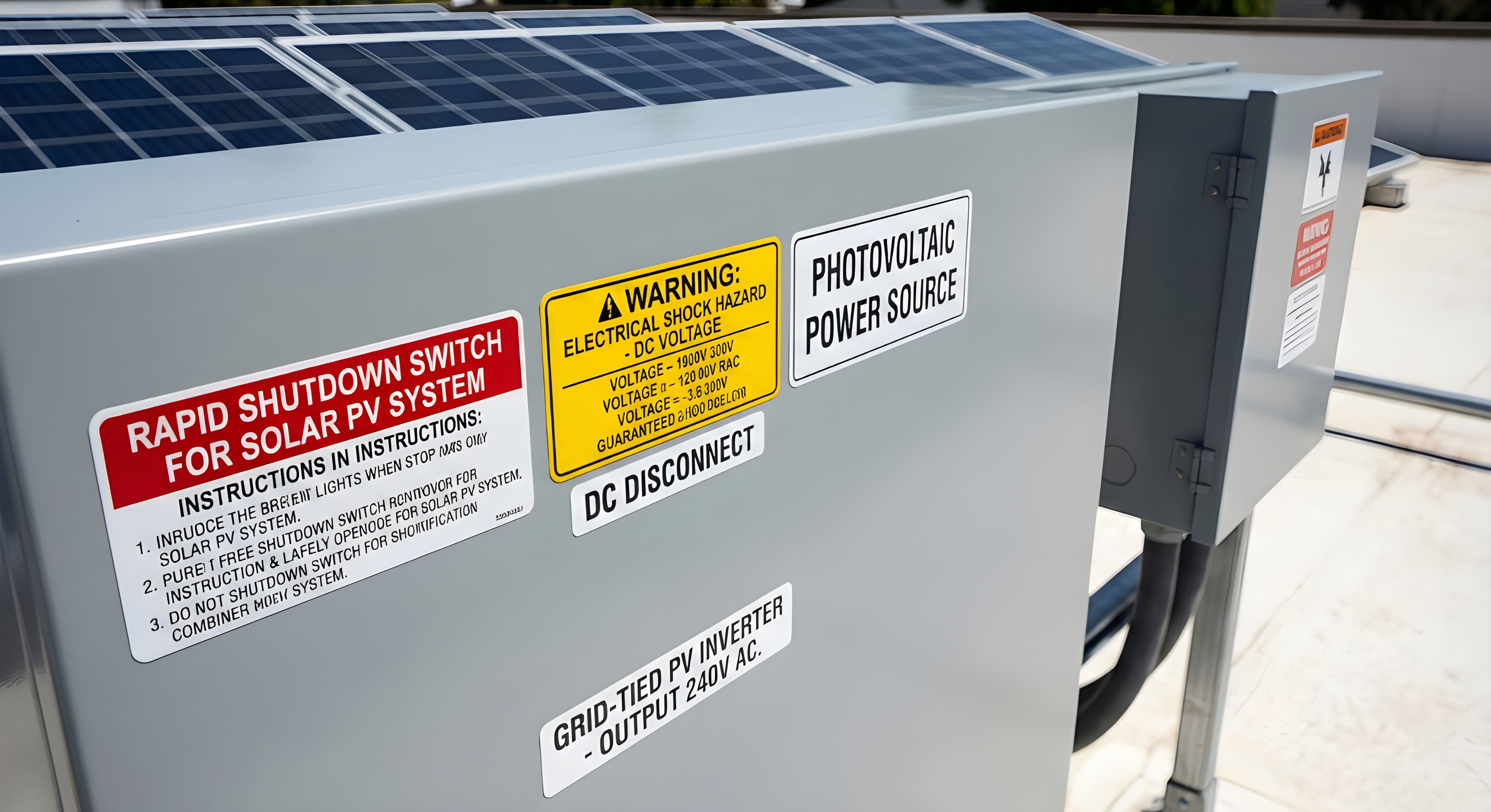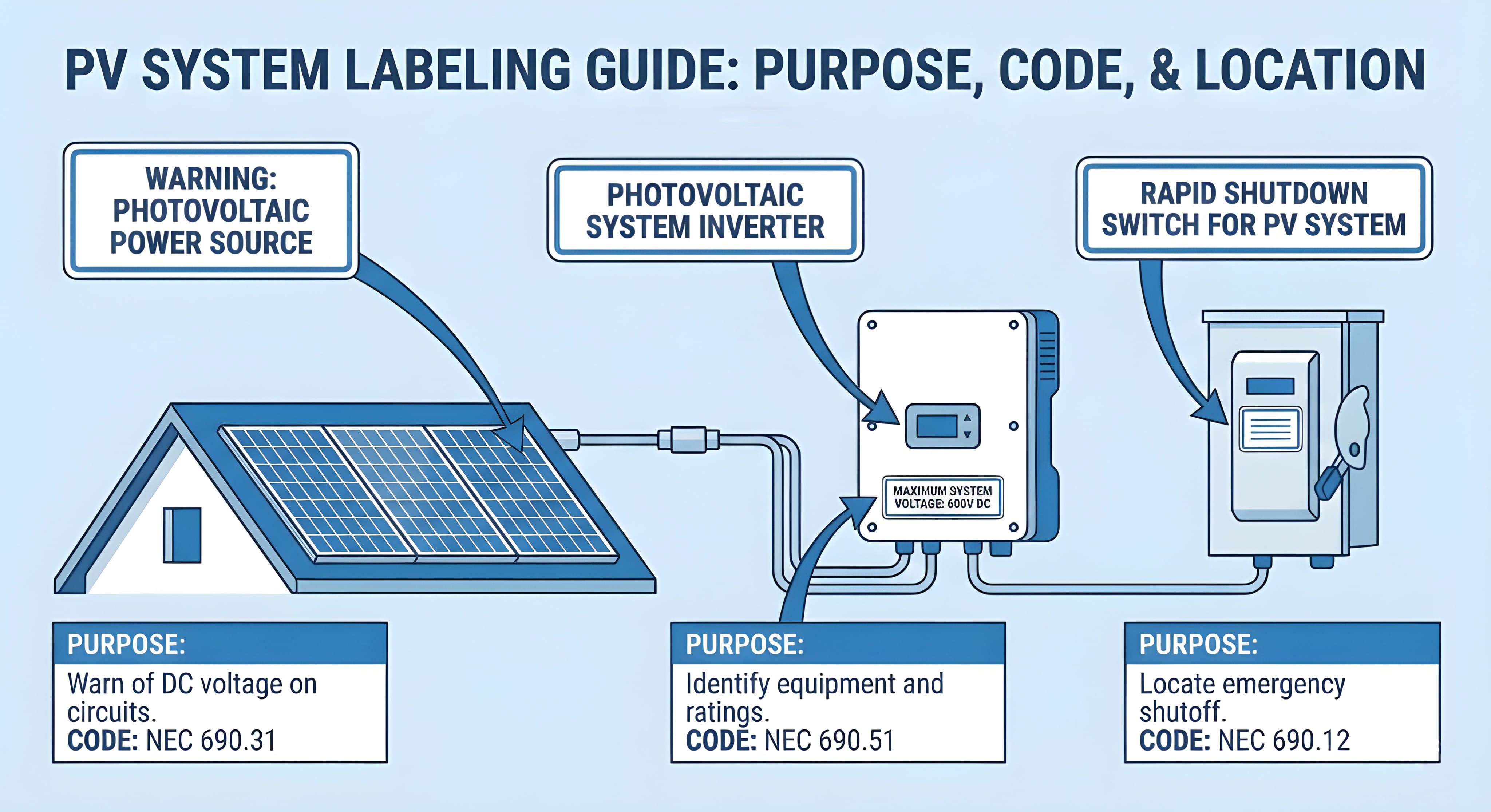

NEC 690.56(C) requires a permanent placard at service equipment for photovoltaic systems with rapid shutdown devices. The mandatory label must state "SOLAR PV SYSTEM EQUIPPED WITH RAPID SHUTDOWN" and specify whether the system controls conductors outside the array boundary only or both inside and outside the boundary. The placard must also indicate the exact location of the rapid shutdown initiation device.
Label specifications include red backgrounds with white lettering, minimum 3/8 inch uppercase letters, and a roof graphic showing the array boundary. Materials must meet NEC 110.21(B) durability standards, with UL 969-rated polyester or polycarbonate recommended. Microinverters and DC optimizers typically require the inside plus outside boundary variant, while string inverters with standard RSD equipment use the outside-only variant. Requirements vary by NEC cycle: 2017 editions use "PHOTOVOLTAIC SYSTEM" language while 2020 and 2023 editions standardize on "SOLAR PV SYSTEM" with two specific format options.
NEC 690.56(C) governs buildings with photovoltaic systems equipped with rapid shutdown capabilities per 690.12. The code requires permanent field markings at service equipment to communicate two critical pieces of information: the presence of rapid shutdown functionality and the scope of conductors deactivated by the RSD. Labels must remain visible at service equipment or grouped service locations and direct responders to the RSD activation point. Requirements vary by jurisdiction based on adopted code cycles and local modifications. Always verify specifications with the authority having jurisdiction.

The fundamental requirement to mark buildings with rapid shutdown capability spans recent code editions. Specific label formats and language vary by adopted version.
2017 Edition (Widely Adopted)
2020 Edition
2023 Edition
Note: Many jurisdictions also require a directory placard per 690.56(B) identifying all power sources at the service location. This directory remains separate from 690.56(C) requirements but receives concurrent review.
SOLAR PV SYSTEM EQUIPPED WITH RAPID SHUTDOWN
Outside-Only Control:
TURN RAPID SHUTDOWN SWITCH TO THE OFF POSITION TO SHUT DOWN PV SYSTEM. CONDUCTORS OUTSIDE THE ARRAY BOUNDARY REDUCE TO A SAFE LEVEL.
Inside and Outside Control (Module-Level or Equivalent):
TURN RAPID SHUTDOWN SWITCH TO THE OFF POSITION TO SHUT DOWN PV SYSTEM. CONDUCTORS INSIDE AND OUTSIDE THE ARRAY BOUNDARY REDUCE TO A SAFE LEVEL.
RAPID SHUTDOWN INITIATION DEVICE LOCATED:
All text should appear in uppercase for optimal readability. Red backgrounds with white lettering provide instant recognition for firefighters. NEC 110.21(B) mandates that field-applied hazard markings be durable and permanently affixed. Materials rated to UL 969 standards and outdoor-grade inks improve inspection pass rates and extend service life.
Service Equipment: Position the 690.56(C) placard on or adjacent to the service disconnect enclosure where it remains plainly visible. Multi-metered or grouped service areas require placement at the group location.
Activation Device: Mark the RSD activation device location with a clear directional statement. Many jurisdictions require the activation device to display 'RAPID SHUTDOWN SWITCH FOR SOLAR PV SYSTEM' at the switch handle.
Colors: Red background with white lettering serves as the recognized standard for emergency responders.
Letter Height: Employ large, high-contrast typography. Many jurisdictions accept minimum 3/8 inch for primary text. Larger sizes provide additional clarity.
Durability: Outdoor exposure to UV radiation, heat, and abrasion degrades inferior labels. UL 969-tested polyester or polycarbonate with UV overlaminate, acrylic adhesive, and rounded corners provide longevity. Attach using rivets or permanent adhesive to metal enclosures after cleaning and drying surfaces. Review installation manuals for equipment-specific requirements.

These systems typically reduce voltage within and outside the array boundary. Apply the label stating conductors inside and outside the boundary reduce to safe levels. Include the roof graphic with visible array boundary lines.
When equipment deactivates DC conductors outside the array while leaving conductors inside the array above safe limits until additional action occurs, apply the outside-only control label. Ensure boundary clarity in the graphic.
Provide a single service placard covering all arrays with a readable roof plan. When arrays differ in control type, supply separate labeled diagrams or a composite graphic noting the applicable type for each array. Professional design services can assist with complex multi-array configurations.
Photovoltaic deployment continues expanding, increasing the significance of responder-safe labeling. U.S. Solar Futures work highlights substantial growth in distributed PV and storage across scenarios, raising rooftop system density in coming years. The IEA has documented accelerating PV deployment and evolving system requirements that emphasize clear operational practices for safety and reliability. Supply chain developments further accelerate adoption. Broader PV scale connects to materials trends and global deployment tracking. As PV and energy storage system volumes increase, minor documentation gaps can cause significant inspection delays. Regional requirements vary significantly, as seen in Texas solar permits and California solar regulations.
Storage performance influences label planning and documentation. Typical LiFePO4 round-trip efficiency ranges from 90 to 95 percent with multi-thousand cycle life at moderate depth of discharge, affecting system sizing and the quantity of rooftop circuits and disconnects requiring clear placarding.

Artwork: Uppercase lettering, high contrast, avoid small serif fonts. Include arrow or text indicating RSD switch location.
Material Components: Polyester or polycarbonate face stock, UV-stable inks, UL 969 or equivalent rating, acrylic permanent adhesive, UV overlaminate.
Installation: Clean metal surface, apply firm pressure, seal edges as needed. Use rivets or screws for textured surfaces.
Documentation: Photograph installed placards for commissioning report; consider adding QR code on placard linking to as-built one-line diagram and RSD instructions stored in project documentation.

Always verify the adopted NEC cycle and local amendments with the authority having jurisdiction.
Proper labeling under NEC 690.56(C) serves as a critical safety component for photovoltaic installations with rapid shutdown systems. Compliance requires understanding which code cycle applies, selecting the correct label variant based on system design, and using durable materials that meet UL 969 standards with high-contrast red and white color schemes.
Investment in quality materials and accurate placement creates faster inspection approvals and demonstrates professional competence. As photovoltaic deployment accelerates, standardized labeling helps build confidence among authorities having jurisdiction, fire departments, and property owners while ensuring emergency responders can quickly identify and operate shutdown devices when needed.
Which labels are mandatory under NEC 690.56(C) for photovoltaic rapid shutdown systems?
A permanent placard must be installed at service equipment identifying that the PV system has rapid shutdown capability. The label must specify the shutdown boundary type, either outside-only or inside plus outside array, and provide clear directions to the activation device location. Additional labeling requirements may apply depending on jurisdiction.
Are roof graphics mandatory for NEC 690.56(C) compliance?
Most jurisdictions operating under 2017, 2020, or 2023 NEC editions require roof graphics. These graphics clarify array boundaries and controlled zones. Some authorities having jurisdiction supply standard templates. Verification with the local plans examiner ensures compliance with specific requirements.
What are the approved colors and letter sizes for rapid shutdown labels?
Red backgrounds with white lettering represent the industry-accepted standard. Most jurisdictions require minimum 3/8 inch uppercase letters for primary text elements. All markings must follow NEC 110.21(B) durability standards. Local preferences should be confirmed before label production.
Is labeling required at the rapid shutdown switch location?
Yes, dual labeling provides optimal safety. The service placard must indicate the activation device location, while a separate label at the switch itself allows responders to immediately identify and operate the shutdown mechanism. This approach aligns with best practices for emergency response.
How should multi-meter buildings handle NEC 690.56(C) labeling?
Multi-meter installations require the 690.56(C) placard at the grouped service location. Each activation device needs clear identification. The separate 690.56(B) directory placard should map all power sources for comprehensive responder information. Commercial installations often have additional requirements.
Can battery storage systems affect rapid shutdown labeling requirements?
RSD labeling under 690.56(C) remains consistent regardless of storage integration. However, battery systems may trigger additional directory requirements and energy storage system signage under separate code sections. Documentation of storage performance characteristics assists inspectors with system evaluation.
What materials provide the longest service life for outdoor PV labels?
Polyester or polycarbonate face stock with UV-stable inks and UL 969 rating delivers optimal durability. UV overlaminate protection, acrylic permanent adhesive, and rounded corners resist weather degradation. Proper surface preparation and mounting techniques extend label lifespan. Review residential guidelines for additional specifications.
Where can current information on photovoltaic safety standards and deployment trends be accessed?
Professional solar design services stay current with evolving standards. Authoritative sources include solar and storage analysis from the U.S. Department of Energy, deployment trends in International Energy Agency reports, market statistics from the International Renewable Energy Agency and U.S. Energy Information Administration, and technology forecasts in Energy Technology Perspectives publications. Additional resources are available through county guidelines and industry updates.
We are dedicated to providing top-notch solar permit services to homeowners, business owners, DIY, and solar installers. Contact us today.